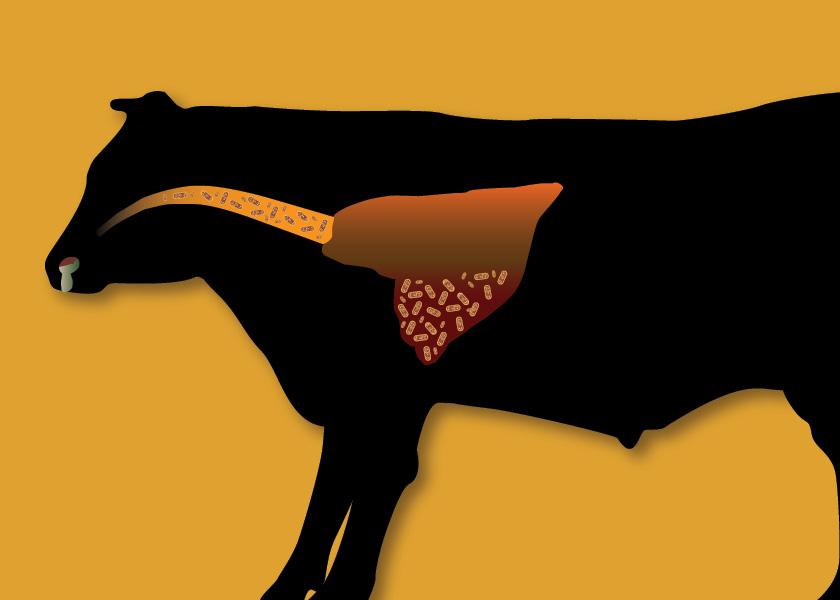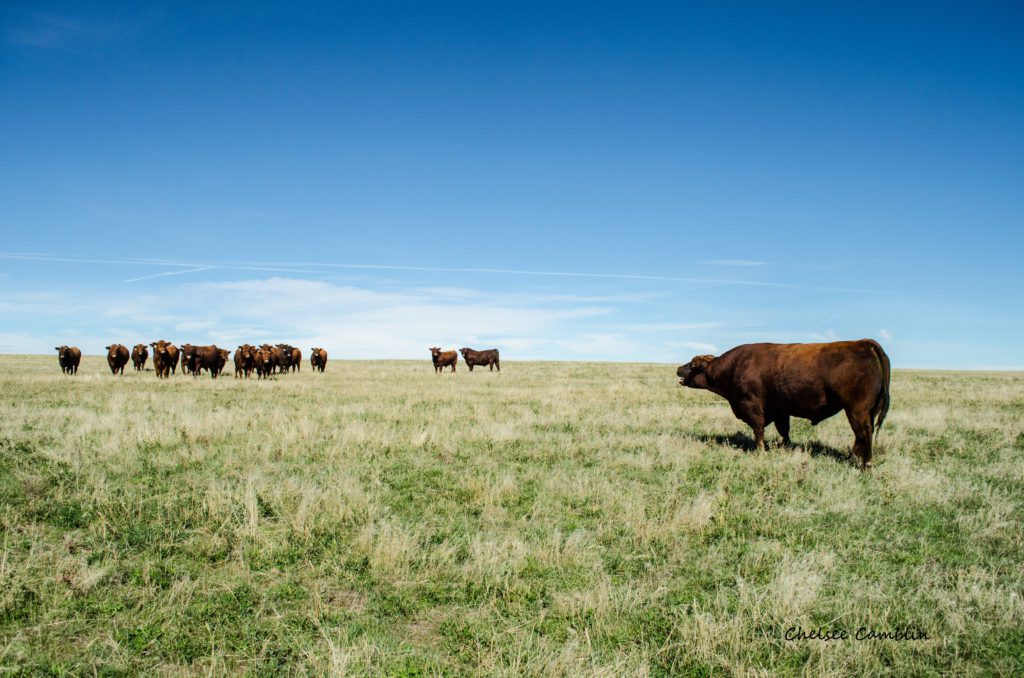Despite millions of dollars of investment in research and years of work to address it, the cattle industry continues to grapple with how to effectively address the disease.
Photo: Alison Fulton
Bovine respiratory disease, BRD, reigns as the costliest disease in the U.S. cattle industry. Despite millions of dollars of investment in research and years of work to address it, the cattle industry continues to grapple with how to effectively address the disease.
Here are seven factors – from the farm to the feedlot – that contribute to BRD as well as some recommendations from veterinarians, Drs. Grant Dewell and Mike Apley, respectively, and Extension nutritionist Paul Beck.
1. Be aware of the knowledge and experience level of farm and feedlot employees.
Observation typically helps identify an animal affected by BRD, and that ability is a learned skill increasingly uncommon today, says Dr. Grant Dewell, DVM, MS, PhD, Iowa State University.
“That depth of experience we had 20 years ago in the feedlot simply isn’t there anymore,” Dewell says.
Fewer experienced eyes in the pen or pasture have potential ramifications on animal health, including incidences of BRD.
“It’s hard to address a problem you don’t know how to identify,” says Dewell, pictured at the left.
“We’re more tuned in to the fact that we need to do more training, especially in the smaller feedlots and backgrounding operations,” he adds. “We spend more time talking about what to look for, what kind of health plan we need to implement and who is going to implement it.”
Paul Beck, PhD, Oklahoma State University Extension nutritionist, says he sometimes sees a BRD break in feedlot cattle occur at roughly the mid-finishing period and offers this observation.
“I think part of the problem with death loss on those cattle is, after you have them 30 days on feed, a lot of our pen riders kind of relax on that set of cattle and then you have a break, and it’s really hard to catch up,” he says.
2. Know the origin of the cattle, their genetics and how they were managed prior to your client taking possession of them.
Veterinarians often anticipate needing to provide more attention to mismanaged cattle or those that come out of certain parts of the country, once they arrive at the feedlot.
But even calves from top genetic lines are often brought down by BRD, a fact that is puzzling for many producers and practitioners alike.
Beck believes part of the issue could be those bigger animals coming into lots look like yearlings but, for all practical purpose, they’re still calves.
“Their systems just aren’t prepared for the rigors of the feedyard, and I think that could be a contributing factor. They have the tools to gain rapidly but I’m not sure they’re set up to not get sick and die,” Beck says.
“Genetics have shifted toward growth and away from disease resistance, so we may need to provide slightly higher protein levels and mineral levels for these high-performing animals,” he adds.
3. Educate cow/calf producers on the value of a preconditioning program.
“If we can precondition those animals on the farm – lower the stress of weaning, bull calves castrated, get them trained to eating at the bunk and vaccinated appropriately – I think we could make a lot of progress in reducing BRD,” says Beck, pictured here.
He also believes going with a longer preconditioning period – 60 to 75 days rather than the more common 45 days – and slowing the growth rate slightly on the farm of origin would improve health and productivity once those animals reach the feedyard.
“I think that extra time can make a big difference in the resilience and ability of cattle to withstand the feedlot environment more successfully,” he says.
4. Consider the nutritional needs of calves arriving at the feedlot.
Calves coming off a truck after a day or two of travel need plenty of water and a combination of high-quality hay and a feed ration that can address their energy needs, Dewell says.
“We need to get some concentrates of some sort into those calves so that they can get their energy levels back up and their immune system can get recovered. That’s going to help them transition to the feedlot better,” he says.
5. Develop a set of written criteria to determine when to pull an animal out of the pasture or pen for closer assessment.
Mike Apley, DVM, PhD, DACVCP, Kansas State University, encourages veterinarians to have a written protocol they can follow as well as use to train producers and their employees.
“A written protocol provides a baseline to discuss treatment eligibility criteria and drug regimens. Discussing results and potential changes in relation to a written protocol is a different scenario than a loose set of treatment strategies.”
Along with the benefit of the discussions leading up to the final protocol, there also needs to be training in implementation, especially for deciding whether an animal is treated for BRD or not.
Apley says a scoring system for the initial identification of animals for treatment can be helpful for training. A zero to 4 system where zero is normal and 4 is unable to rise is a common system.
“If the trainer and trainee are debating between a 1 and a 2, or a 2 and a 3, no problem. If the debate is between a 1 and a 3, that is where the discussion will be especially valuable,” he says. “The scoring system is primarily based on depression with additional inputs such as rumen fill, dehydration (sunken eyes), and discharge from the eyes or nose.
“If you talk yourself out of pulling an animal once and they catch your attention again, they should come out of the pen,” says Apley, pictured here.
Along with the scoring system, Apley suggests using a set of secondary criteria for the evaluation process which are applied in the treatment chute, noting that the time for a visual score has passed.
The long-time standard for chute-side evaluation has been the thermometer.
“I don’t know the perfect cutoff temperature, but it probably varies with environmental temperature,” he says. “A minimum of 103.5°F with a common cutoff of 104.0°F are standards.”
Some chute-side technologies are available to help diagnose animals with BRD. They include the Whisper On Arrival stethoscope, and the automated white blood cell differential test, QScout BLD. Purdue University researchers are also working on a pen-side test for BRD that is still in development.
6. While antibiotic selection is a matter of veterinary preference, give thought to your treatment strategy.
“The introduction of long-acting oxytetracycline dates back to around 1980, followed by tilmicosin in 1992 which started the change to where we are today, largely using single-injection antimicrobials in cattle with BRD,” Apley says.
There is now a wide selection of single-injection antimicrobial options for BRD. Strategies are developed for order of antimicrobials to be used in the treatment protocol, both with and without administering an antimicrobial for control of BRD at arrival.
“The interesting thing about all of the strategies is that we talk about the antimicrobials as if that is all of the picture,” Apley says. “The equal part of the success/failure equation is the nature of the resistance genes in the BRD pathogens circulating in the cattle; we don’t know this status at the start for a group of cattle. If the resistance genes aren’t there, then the rotations don’t really matter other than for comparative efficacy.
“If the resistance genes are present, the diagnostic lab data suggest that the pathogens are often multiple drug resistant (MDR), for example due to the Integrative Conjugative Element (ICE) that encodes for resistance to most of the antimicrobials we use for BRD,” he adds. “In this case, the order of antimicrobial use doesn’t matter much either.”
Apley suggests starting with an antimicrobial based on efficacy and how it fits in your program. He says it then makes sense to switch to a different class for subsequent therapy, in case a lack of initial treatment response was due to resistance to the first product. Lack of treatment response can be due to many other factors besides antimicrobial resistance.
In addition, Apley says he does not recommend the use of any other products, such as vitamins, in conjunction with the antibiotic. “The published evidence that any other drug combined with an antimicrobial changes the outcome of BRD remains nonexistent. If a drug such as a non-steroidal anti-inflammatory can make them more comfortable without decreasing treatment response, that is fine. Just don’t think you are changing your success/failure proportions for treatment outcome.”
7. Determine what you believe is an adequate post-treatment interval and decide next steps.
Apley says an often neglected part of a treatment protocol is consciously deciding upon a period for determining if the animal has recovered or needs additional therapy. This is the post-treatment interval (PTI).
“Looking at the data across the different antimicrobials, I think a starting point of a seven-day PTI is reasonable for most of the single-injection products.” he says. “There also needs to be a method for indicating the date for which each animal is to be evaluated at the end of the PTI. Some have used lists of ear tag numbers or use chalk to mark dates on the cattle.”
An animal that is making progress may need no further treatment, but veterinarians need to have a process by which they make a judgment call, Dewell says.
“If the animal needs additional treatment, you might put it into a convalescent pen. You also need to decide if the animal is going to recover. If it’s not, we need to euthanize it humanely sooner rather than later,” he says. “These are not always easy decisions to make, but they are things we all need to be working toward and thinking about. We have to manage the individual as well as the herd.”
Despite millions of dollars of investment in research and years of work to address it, the cattle industry continues to grapple with how to effectively address the disease. (Alison Fulton)
Source: By Rhonda Brooks September 20, 2023, Bovine Veterinarian








